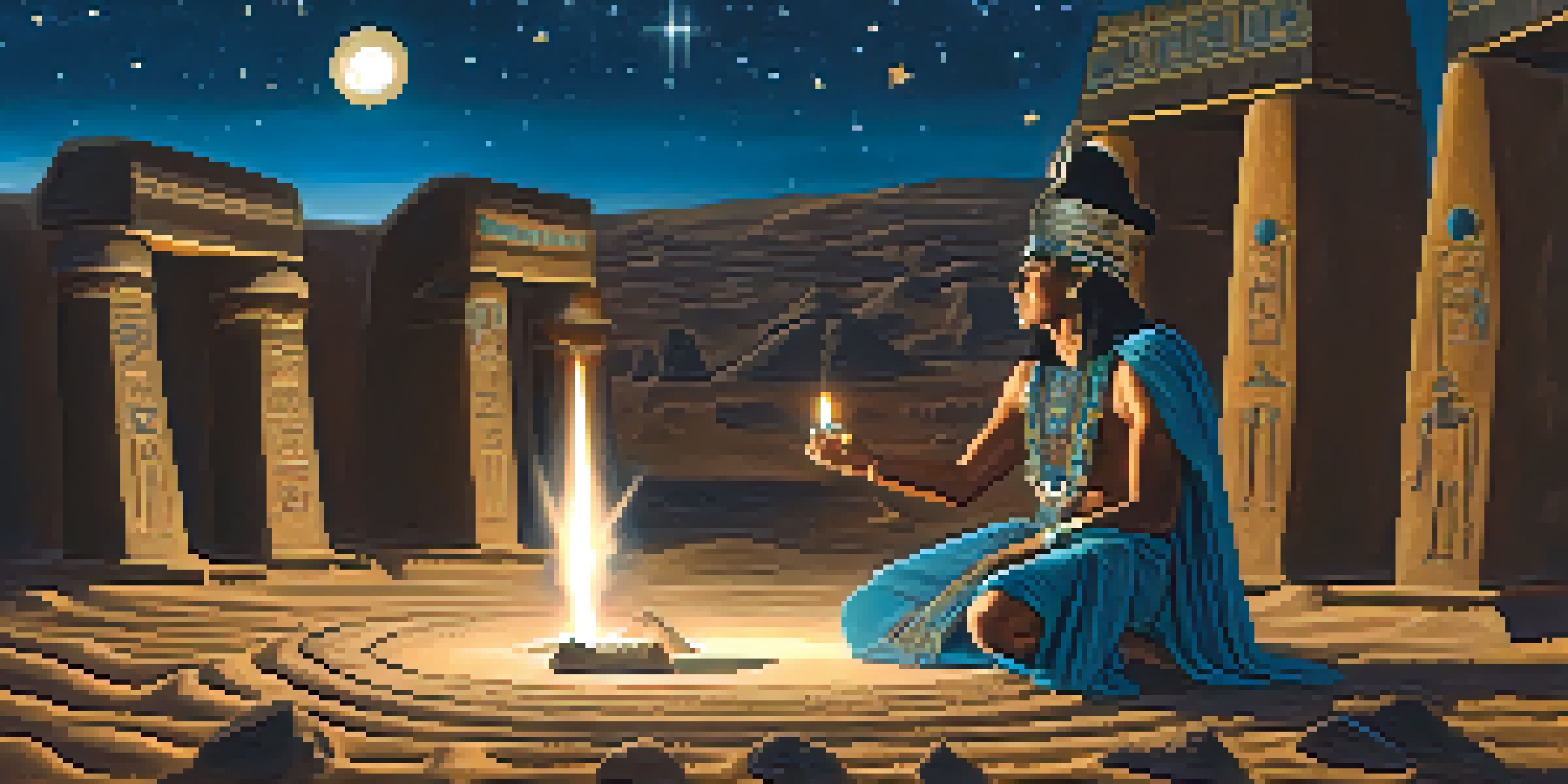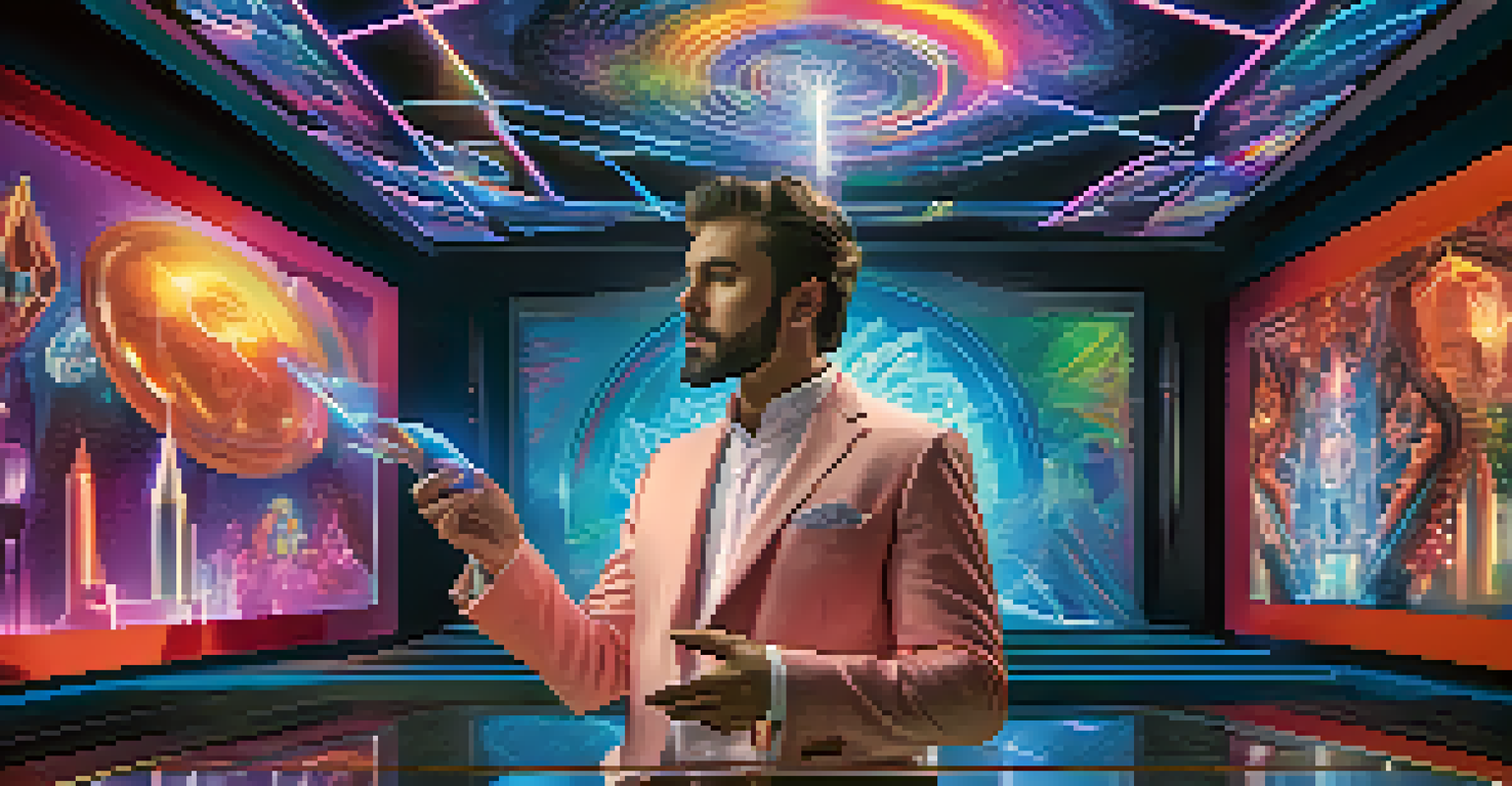The History of Magic: From Ancient Practices to Modern Illusions

The Roots of Magic: Ancient Practices and Beliefs
Magic has its origins in ancient civilizations, where it was often intertwined with religion and spirituality. Early practitioners, known as shamans or priests, used rituals to connect with deities or tap into the supernatural. These practices were rooted in the belief that they could influence the world around them, whether for healing or protection.
Magic is the art of causing changes in consciousness according to will.
In cultures like ancient Egypt, magic was a vital part of daily life, with spells and charms used to ward off evil or ensure a bountiful harvest. The famous Book of the Dead, filled with spells for the afterlife, illustrates how deeply embedded magic was in their beliefs. This fusion of spirituality and magic laid the groundwork for the traditions that would evolve over centuries.
As societies advanced, these ancient practices shifted from spiritual rituals to more entertainment-focused forms. However, the essence of magic as a mysterious force remained, captivating people’s imaginations and leading to the development of various magical arts.
The Rise of the Magician: Medieval and Renaissance Magic
During the Middle Ages, magic took on a more structured form, often blending with science and alchemy. The rise of alchemists, who sought to transform base metals into gold, demonstrated a more scholarly approach to magic. Figures like Paracelsus began to bridge the gap between magic and medicine, emphasizing the importance of observation and experimentation.

The Renaissance sparked a revival in interest in the mystical arts, with magicians like John Dee and Cornelius Agrippa gaining prominence. They combined magic with philosophy, astrology, and mathematics, creating a rich tapestry of knowledge that fascinated and terrified people alike. This period saw magic transitioning into a form of entertainment, with performances that dazzled audiences.
Magic's Ancient Spiritual Roots
Magic originated in ancient civilizations, closely linked to religion and spirituality, where rituals aimed to influence the world.
The emergence of public magic shows began to transform the perception of magicians, who were now seen as entertainers rather than just spiritual leaders. This shift set the stage for the modern magician, as performances became more elaborate and theatrical, captivating audiences across Europe.
The Golden Age of Magic: Vaudeville and the Stage
The late 19th and early 20th centuries are often referred to as the Golden Age of Magic, characterized by grand performances in theaters and vaudeville shows. Magicians like Harry Houdini and Howard Thurston captivated audiences with their daring escapes and elaborate illusions. These performances combined artistry with showmanship, making magic a popular form of entertainment.
The magician and the politician have much in common: they both use the illusion of control to create a desired effect.
During this time, the art of magic also benefited from technological advancements. The introduction of stage lighting and elaborate sets allowed magicians to create stunning visual effects that enhanced their performances. This era marked a significant shift as magic became a respected profession, drawing large crowds eager to be amazed.
As magicians began to reach celebrity status, they also faced challenges, including skepticism and the rise of debunkers. However, this only fueled their creativity, leading to innovations in magic that would continue to evolve in the years to come. The Golden Age firmly established magic as a beloved form of entertainment worldwide.
The Evolution of Illusions: 20th Century Innovations
The 20th century ushered in a wave of innovation in the world of magic, with magicians like David Copperfield and Penn & Teller pushing the boundaries of what was possible. Their performances incorporated technology, storytelling, and audience participation, creating a more immersive experience. This evolution made magic accessible to a broader audience, captivating viewers on television and live stages alike.
Television played a significant role in popularizing magic, with shows like 'The Magic of David Copperfield' reaching millions of viewers. The small screen allowed magicians to showcase their tricks in ways that were previously unimaginable, such as performing illusions in iconic locations. This exposure transformed magicians into household names and redefined the art of magic.
Entertainment Evolution in Magic
From the Middle Ages to the Golden Age, magic transformed from spiritual practices into captivating entertainment, engaging audiences worldwide.
As magic continued to evolve, so did the methods and styles of performance. New genres emerged, including mentalism and close-up magic, each offering unique experiences. This diversification ensured that magic remained fresh and exciting, appealing to audiences of all ages and backgrounds.
Magic in the Digital Age: Technology and Illusions
The advent of the internet and digital technology has transformed the landscape of magic, allowing performers to reach global audiences. Social media platforms enable magicians to share their tricks and connect with fans, creating a new generation of magic enthusiasts. Online performances and tutorials have made magic more accessible than ever, inspiring aspiring magicians around the world.
With advancements in technology, magicians are now incorporating elements like augmented reality and virtual reality into their performances. This fusion of magic and technology creates a unique experience that captivates modern audiences, blurring the lines between reality and illusion. It showcases the adaptability of magic, ensuring its relevance in the contemporary world.
However, the digital age also presents challenges, such as the proliferation of magic-related content that can sometimes reveal secrets. Despite this, many magicians embrace these changes, using them as opportunities to innovate and inspire. The digital era continues to redefine what magic means, proving its enduring appeal.
Cultural Perspectives on Magic: Global Traditions
Magic is not confined to any one culture; it exists in various forms around the globe, each reflecting unique beliefs and traditions. In many indigenous cultures, magic often intertwines with spirituality and community practices, from shamanism in Siberia to voodoo in Haiti. These practices serve as a means of connecting with the spiritual world and addressing societal issues.
In contrast, Western magic, often seen as entertainment, focuses on illusions and tricks designed to amaze and amuse. This divergence highlights the rich tapestry of magical practices, showcasing how culture shapes the perception and purpose of magic. The similarities and differences provide fascinating insights into human creativity and belief systems.
Magic's Future in a Digital World
With advancements in technology and a focus on inclusivity, magic is set to evolve further, embracing new platforms and diverse performers.
As globalization continues to expand, the cross-cultural exchange of magical practices is becoming more prevalent. Magicians today often draw inspiration from diverse traditions, blending techniques and styles to create unique performances. This cultural fusion enriches the art of magic, allowing it to evolve and resonate with a wider audience.
The Future of Magic: Trends and Innovations Ahead
As we look to the future, magic is poised to continue evolving in exciting ways. With a growing emphasis on inclusivity and diversity, more performers from various backgrounds are stepping into the spotlight, bringing fresh perspectives and styles. This shift enriches the art form, making it more representative of our global society.
Innovative technology will likely play a critical role in the future of magic, with advancements in AI and interactive experiences shaping performances. Imagine attending a magic show where audience members can participate in real-time through virtual platforms or holograms. Such developments could redefine the relationship between the magician and the audience, fostering deeper engagement.

Ultimately, the future of magic lies in its ability to adapt and inspire. As new generations of magicians emerge, they will undoubtedly bring their unique visions and ideas, ensuring that magic continues to captivate and amaze audiences for years to come. The journey of magic is far from over, and its evolution promises to be as enchanting as its storied past.